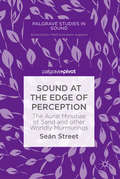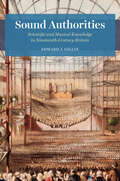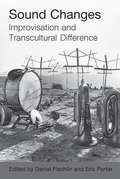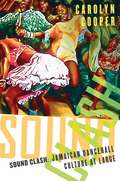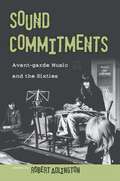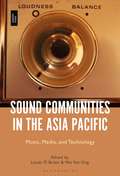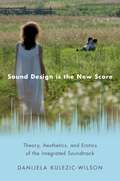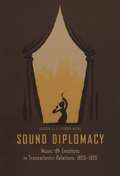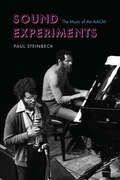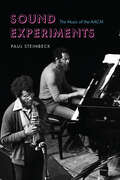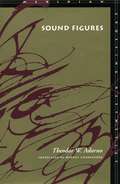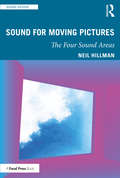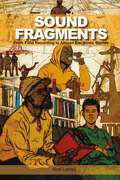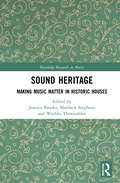- Table View
- List View
Sound at the Edge of Perception: The Aural Minutiae of Sand and other Worldly Murmurings (Palgrave Studies in Sound)
by Seán StreetThis book is about the tiny sounds of the world, and listening to them, the minute signals that are clues to who and where we are. A very small sound, given the context of its history, becomes hugely significant, and even an imagined sound in a picture becomes almost a voice. By speaking a name, we give a person back to the world, and a breath, a sigh, a laugh or a cry need no language. A phoneme is the start of all stories, and were we able to tune ourselves to the subtleties of the natural world, we might share the super-sensitivity of members of the bird and animal kingdom to sense the message in the apparent silence. Mind hears sound when it perceives an image; the book will appeal to sonic and radio practitioners, students of sound, those working in the visual arts, and creative writers.
Sound at the Edge of Perception: The Aural Minutiae of Sand and other Worldly Murmurings (Palgrave Studies in Sound)
by Seán StreetThis book is about the tiny sounds of the world, and listening to them, the minute signals that are clues to who and where we are. A very small sound, given the context of its history, becomes hugely significant, and even an imagined sound in a picture becomes almost a voice. By speaking a name, we give a person back to the world, and a breath, a sigh, a laugh or a cry need no language. A phoneme is the start of all stories, and were we able to tune ourselves to the subtleties of the natural world, we might share the super-sensitivity of members of the bird and animal kingdom to sense the message in the apparent silence. Mind hears sound when it perceives an image; the book will appeal to sonic and radio practitioners, students of sound, those working in the visual arts, and creative writers.
Sound Authorities: Scientific and Musical Knowledge in Nineteenth-Century Britain
by Edward J. GillinSound Authorities shows how experiences of music and sound played a crucial role in nineteenth-century scientific inquiry in Britain. In Sound Authorities, Edward J. Gillin focuses on hearing and aurality in Victorian Britain, claiming that the development of the natural sciences in this era cannot be understood without attending to the study of sound and music. During this time, scientific practitioners attempted to fashion themselves as authorities on sonorous phenomena, coming into conflict with traditional musical elites as well as religious bodies. Gillin pays attention to sound in both musical and nonmusical contexts, specifically the cacophony of British industrialization. Sound Authorities begins with the place of acoustics in early nineteenth-century London, examining scientific exhibitions, lectures, spectacles, workshops, laboratories, and showrooms. He goes on to explore how mathematicians mobilized sound in their understanding of natural laws and their vision of a harmonious ordered universe. In closing, Gillin delves into the era’s religious and metaphysical debates over the place of music (and humanity) in nature, the relationship between music and the divine, and the tensions between spiritualist understandings of sound and scientific ones.
Sound Authorities: Scientific and Musical Knowledge in Nineteenth-Century Britain
by Edward J. GillinSound Authorities shows how experiences of music and sound played a crucial role in nineteenth-century scientific inquiry in Britain. In Sound Authorities, Edward J. Gillin focuses on hearing and aurality in Victorian Britain, claiming that the development of the natural sciences in this era cannot be understood without attending to the study of sound and music. During this time, scientific practitioners attempted to fashion themselves as authorities on sonorous phenomena, coming into conflict with traditional musical elites as well as religious bodies. Gillin pays attention to sound in both musical and nonmusical contexts, specifically the cacophony of British industrialization. Sound Authorities begins with the place of acoustics in early nineteenth-century London, examining scientific exhibitions, lectures, spectacles, workshops, laboratories, and showrooms. He goes on to explore how mathematicians mobilized sound in their understanding of natural laws and their vision of a harmonious ordered universe. In closing, Gillin delves into the era’s religious and metaphysical debates over the place of music (and humanity) in nature, the relationship between music and the divine, and the tensions between spiritualist understandings of sound and scientific ones.
Sound Changes: Improvisation and Transcultural Difference
by Daniel Fischlin Eric PorterSound Changes responds to a need in improvisation studies for more work that addresses the diversity of global improvisatory practices and argues that by beginning to understand the particular, material experiences of sonic realities that are different from our own, we can address the host of other factors that are imparted or sublimated in performance. These factors range from the intimate affect associated with a particular performer’s capacity to generate a distinctive “voicing,” or the addition of an unexpected sonic intervention only possible with one particular configuration of players in a specific space and time. Through a series of case studies drawn from Africa, Asia, the Americas, and Oceania, Sound Changes offers readers an introduction to a range of musical expressions across the globe in which improvisation plays a key role and the book demonstrates that improvisation is a vital site for the production of emergent social relationships and meanings. As it does this work, Sound Changes situates the increasingly transcultural dimensions of improvised music in relation to emergent networks and technologies, changing patterns of migration and immigration, shifts in the political economy of music, and other social, cultural, and economic factors. Improvisation studies is a recently developed, but growing, interdisciplinary field of study. The discipline—which has only truly come into focus in the early part of the twenty-first century—has been building a lexicon of key terms and developing assumptions about core practices. Yet, the full breadth of improvisatory practices has remained a vexed, if not impossibly ambitious, subject of study. This volume offers a step forward in the movement away from critical tendencies that tend to homogenize and reduce practices and vocabularies in the name of the familiar.
Sound Clash: Jamaican Dancehall Culture at Large
by C. CooperMegawattage sound systems have blasted the electronically-enhanced riddims and tongue-twisting lyrics of Jamaica's dancehall DJs across the globe. This high-energy raggamuffin music is often dismissed by old-school roots reggae fans as a raucous degeneration of classic Jamaican popular music. In this provocative study of dancehall culture, Cooper offers a sympathetic account of the philosophy of a wide range of dancehall DJs: Shabba Ranks, Lady Saw, Ninjaman, Capleton, Buju Banton, Anthony B and Apache Indian. Cooper also demonstrates the ways in which the language of dancehall culture, often devalued as mere 'noise,' articulates a complex understanding of the border clashes which characterize Jamaican society, and analyzes the sound clashes that erupt in the movement of Jamaican dancehall culture across national borders.
Sound Commitments: Avant-Garde Music and the Sixties
by Robert AdlingtonThe role of popular music is widely recognized in giving voice to radical political views, the plight of the oppressed, and the desire for social change. Avant-garde music, by contrast, is often thought to prioritize the pursuit of new technical or conceptual territory over issues of human and social concern. Yet throughout the activist 1960s, many avant-garde musicians were convinced that aesthetic experiment and social progressiveness made natural bedfellows. Intensely involved in the era's social and political upheavals, they often sought to reflect this engagement in their music. Yet how could avant-garde musicians make a meaningful contribution to social change if their music remained the preserve of a tiny, initiated clique? In answer, Sound Commitments, examines the encounter of avant-garde music and "the Sixties" across a range of genres, aesthetic positions and geographical locations. Through music for the concert hall, tape and electronic music, jazz and improvisation, participatory "events," performance art, and experimental popular music, the essays in this volume explore developments in the United States, France, West Germany, Italy, the Netherlands, the Soviet Union, Japan and parts of the "Third World," delving into the deep richness of avant-garde musicians' response to the decade's defining cultural shifts. Featuring new archival research and/or interviews with significant figures of the period in each chapter, Sound Commitments will appeal to researchers and advanced students in the fields of post-war music, cultures of the 1960s, and the avant-garde, as well as to an informed general readership.
Sound Communities in the Asia Pacific: Music, Media, and Technology
by Lonán Ó Briain and Min Yen OngThe popularization of radio, television, and the Internet radically transformed musical practice in the Asia Pacific. These technologies bequeathed media broadcasters with a profound authority over the ways we engage with musical culture. Broadcasters use this power to promote distinct cultural traditions, popularize new music, and engage diverse audiences. They also deploy mediated musics as a vehicle for disseminating ideologies, educating the masses, shaping national borders, and promoting political alliances. With original contributions by leading scholars in anthropology, ethnomusicology, sound studies, and media and cultural studies, the 12 essays this book investigate the processes of broadcasting musical culture in the Asia Pacific. We shift our gaze to the mechanisms of cultural industries in eastern Asia and the Pacific islands to understand how oft-invisible producers, musicians, and technologies facilitate, frame, reproduce, and magnify the reach of local culture.
Sound Communities in the Asia Pacific: Music, Media, and Technology
The popularization of radio, television, and the Internet radically transformed musical practice in the Asia Pacific. These technologies bequeathed media broadcasters with a profound authority over the ways we engage with musical culture. Broadcasters use this power to promote distinct cultural traditions, popularize new music, and engage diverse audiences. They also deploy mediated musics as a vehicle for disseminating ideologies, educating the masses, shaping national borders, and promoting political alliances. With original contributions by leading scholars in anthropology, ethnomusicology, sound studies, and media and cultural studies, the 12 essays this book investigate the processes of broadcasting musical culture in the Asia Pacific. We shift our gaze to the mechanisms of cultural industries in eastern Asia and the Pacific islands to understand how oft-invisible producers, musicians, and technologies facilitate, frame, reproduce, and magnify the reach of local culture.
Sound Design is the New Score: Theory, Aesthetics, and Erotics of the Integrated Soundtrack (Oxford Music/Media Series)
by Danijela Kulezic-WilsonThe practice of blurring the line between score and sound design has transformed contemporary film soundscape by challenging not only the long-established hierarchical relationships between dialogue, music, and sound effects, but also the modes of perception shaped by classical soundtrack practices. The methods of this new trend rely on the language of contemporary popular and art music, producing soundtracks in which it is difficult to tell the difference between score and ambient sound, where pieces of electroacoustic music are merged with diegetic sound, sound effects are absorbed into the score or treated as music, and diegetic sound is treated as musique concrète. In Sound Design is the New Score, Kulezic-Wilson explores theoretical, aesthetic, and sensuous dimensions of this new trend, providing a multifaceted portrait of a practice which recognizes the interconnectedness of all soundtrack elements and emphasizes their inherent musicality. The aesthetic concerns of this practice are illuminated through the concept of the aesthetics of reticence which rejects classical narrative and scoring conventions and uses integrated soundtrack strategies to create the space for mystery in art and for individuality in the cinematic experience. The book's emphasis on sensuous and musical aspects of this practice, informed by the feminist discourse on the erotics of art, challenges popular notions about sensory cinema, demonstrating that the sensuousness of film form and its soundscapes is more sophisticated than simply being the result of excessive sensory stimulation facilitated by the use of digital technology or the "intensified" aesthetics it inspires. The discussion is supported by a wide range of case studies from American Independent, Asian, Australian, and European cinemas, including films by Shane Carruth, Claire Denis, Hou Hsiao-Hsien, Harmony Korine, David Michôd, Gus Van Sant, and Peter Strickland.
SOUND DESIGN IS THE NEW SCORE OMMS C: Theory, Aesthetics, and Erotics of the Integrated Soundtrack (Oxford Music/Media Series)
by Danijela Kulezic-WilsonThe practice of blurring the line between score and sound design has transformed contemporary film soundscape by challenging not only the long-established hierarchical relationships between dialogue, music, and sound effects, but also the modes of perception shaped by classical soundtrack practices. The methods of this new trend rely on the language of contemporary popular and art music, producing soundtracks in which it is difficult to tell the difference between score and ambient sound, where pieces of electroacoustic music are merged with diegetic sound, sound effects are absorbed into the score or treated as music, and diegetic sound is treated as musique concrète. In Sound Design is the New Score, Kulezic-Wilson explores theoretical, aesthetic, and sensuous dimensions of this new trend, providing a multifaceted portrait of a practice which recognizes the interconnectedness of all soundtrack elements and emphasizes their inherent musicality. The aesthetic concerns of this practice are illuminated through the concept of the aesthetics of reticence which rejects classical narrative and scoring conventions and uses integrated soundtrack strategies to create the space for mystery in art and for individuality in the cinematic experience. The book's emphasis on sensuous and musical aspects of this practice, informed by the feminist discourse on the erotics of art, challenges popular notions about sensory cinema, demonstrating that the sensuousness of film form and its soundscapes is more sophisticated than simply being the result of excessive sensory stimulation facilitated by the use of digital technology or the "intensified" aesthetics it inspires. The discussion is supported by a wide range of case studies from American Independent, Asian, Australian, and European cinemas, including films by Shane Carruth, Claire Denis, Hou Hsiao-Hsien, Harmony Korine, David Michôd, Gus Van Sant, and Peter Strickland.
Sound Diplomacy: Music and Emotions in Transatlantic Relations, 1850-1920
by Jessica C. Gienow-HechtThe German-American relationship was special long before the Cold War; it was rooted not simply in political actions, but also long-term traditions of cultural exchange that date back to the nineteenth century. Between 1850 and 1910, the United States was a rising star in the international arena, and several European nations sought to strengthen their ties to the republic by championing their own cultures in America. While France capitalized on its art and Britain on its social ties and literature, Germany promoted its particular breed of classical music. Delving into a treasure trove of archives that document cross-cultural interactions between America and Germany, Jessica Gienow-Hecht retraces these efforts to export culture as an instrument of nongovernmental diplomacy, paying particular attention to the role of conductors, and uncovers the remarkable history of the musician as a cultural symbol of German cosmopolitanism. Considered sexually attractive and emotionally expressive, German players and conductors acted as an army of informal ambassadors for their home country, and Gienow-Hecht argues that their popularity in the United States paved the way for an emotional elective affinity that survived broken treaties and several wars and continues to the present.
Sound Diplomacy: Music and Emotions in Transatlantic Relations, 1850-1920
by Jessica C. Gienow-HechtThe German-American relationship was special long before the Cold War; it was rooted not simply in political actions, but also long-term traditions of cultural exchange that date back to the nineteenth century. Between 1850 and 1910, the United States was a rising star in the international arena, and several European nations sought to strengthen their ties to the republic by championing their own cultures in America. While France capitalized on its art and Britain on its social ties and literature, Germany promoted its particular breed of classical music. Delving into a treasure trove of archives that document cross-cultural interactions between America and Germany, Jessica Gienow-Hecht retraces these efforts to export culture as an instrument of nongovernmental diplomacy, paying particular attention to the role of conductors, and uncovers the remarkable history of the musician as a cultural symbol of German cosmopolitanism. Considered sexually attractive and emotionally expressive, German players and conductors acted as an army of informal ambassadors for their home country, and Gienow-Hecht argues that their popularity in the United States paved the way for an emotional elective affinity that survived broken treaties and several wars and continues to the present.
Sound Diplomacy: Music and Emotions in Transatlantic Relations, 1850-1920
by Jessica C. Gienow-HechtThe German-American relationship was special long before the Cold War; it was rooted not simply in political actions, but also long-term traditions of cultural exchange that date back to the nineteenth century. Between 1850 and 1910, the United States was a rising star in the international arena, and several European nations sought to strengthen their ties to the republic by championing their own cultures in America. While France capitalized on its art and Britain on its social ties and literature, Germany promoted its particular breed of classical music. Delving into a treasure trove of archives that document cross-cultural interactions between America and Germany, Jessica Gienow-Hecht retraces these efforts to export culture as an instrument of nongovernmental diplomacy, paying particular attention to the role of conductors, and uncovers the remarkable history of the musician as a cultural symbol of German cosmopolitanism. Considered sexually attractive and emotionally expressive, German players and conductors acted as an army of informal ambassadors for their home country, and Gienow-Hecht argues that their popularity in the United States paved the way for an emotional elective affinity that survived broken treaties and several wars and continues to the present.
Sound Diplomacy: Music and Emotions in Transatlantic Relations, 1850-1920
by Jessica C. Gienow-HechtThe German-American relationship was special long before the Cold War; it was rooted not simply in political actions, but also long-term traditions of cultural exchange that date back to the nineteenth century. Between 1850 and 1910, the United States was a rising star in the international arena, and several European nations sought to strengthen their ties to the republic by championing their own cultures in America. While France capitalized on its art and Britain on its social ties and literature, Germany promoted its particular breed of classical music. Delving into a treasure trove of archives that document cross-cultural interactions between America and Germany, Jessica Gienow-Hecht retraces these efforts to export culture as an instrument of nongovernmental diplomacy, paying particular attention to the role of conductors, and uncovers the remarkable history of the musician as a cultural symbol of German cosmopolitanism. Considered sexually attractive and emotionally expressive, German players and conductors acted as an army of informal ambassadors for their home country, and Gienow-Hecht argues that their popularity in the United States paved the way for an emotional elective affinity that survived broken treaties and several wars and continues to the present.
Sound Diplomacy: Music and Emotions in Transatlantic Relations, 1850-1920
by Jessica C. Gienow-HechtThe German-American relationship was special long before the Cold War; it was rooted not simply in political actions, but also long-term traditions of cultural exchange that date back to the nineteenth century. Between 1850 and 1910, the United States was a rising star in the international arena, and several European nations sought to strengthen their ties to the republic by championing their own cultures in America. While France capitalized on its art and Britain on its social ties and literature, Germany promoted its particular breed of classical music. Delving into a treasure trove of archives that document cross-cultural interactions between America and Germany, Jessica Gienow-Hecht retraces these efforts to export culture as an instrument of nongovernmental diplomacy, paying particular attention to the role of conductors, and uncovers the remarkable history of the musician as a cultural symbol of German cosmopolitanism. Considered sexually attractive and emotionally expressive, German players and conductors acted as an army of informal ambassadors for their home country, and Gienow-Hecht argues that their popularity in the United States paved the way for an emotional elective affinity that survived broken treaties and several wars and continues to the present.
Sound Diplomacy: Music and Emotions in Transatlantic Relations, 1850-1920
by Jessica C. Gienow-HechtThe German-American relationship was special long before the Cold War; it was rooted not simply in political actions, but also long-term traditions of cultural exchange that date back to the nineteenth century. Between 1850 and 1910, the United States was a rising star in the international arena, and several European nations sought to strengthen their ties to the republic by championing their own cultures in America. While France capitalized on its art and Britain on its social ties and literature, Germany promoted its particular breed of classical music. Delving into a treasure trove of archives that document cross-cultural interactions between America and Germany, Jessica Gienow-Hecht retraces these efforts to export culture as an instrument of nongovernmental diplomacy, paying particular attention to the role of conductors, and uncovers the remarkable history of the musician as a cultural symbol of German cosmopolitanism. Considered sexually attractive and emotionally expressive, German players and conductors acted as an army of informal ambassadors for their home country, and Gienow-Hecht argues that their popularity in the United States paved the way for an emotional elective affinity that survived broken treaties and several wars and continues to the present.
Sound Experiments: The Music of the AACM
by Paul SteinbeckA groundbreaking study of the trailblazing music of Chicago’s AACM, a leader in the world of jazz and experimental music. Founded on Chicago’s South Side in 1965 and still thriving today, the Association for the Advancement of Creative Musicians (AACM) is the most influential collective organization in jazz and experimental music. In Sound Experiments, Paul Steinbeck offers an in-depth historical and musical investigation of the collective, analyzing individual performances and formal innovations in captivating detail. He pays particular attention to compositions by Muhal Richard Abrams and Roscoe Mitchell, the Association’s leading figures, as well as Anthony Braxton, George Lewis (and his famous computer-music experiment, Voyager), Wadada Leo Smith, and Henry Threadgill, along with younger AACM members such as Mike Reed, Tomeka Reid, and Nicole Mitchell. Sound Experiments represents a sonic history, spanning six decades, that affords insight not only into the individuals who created this music but also into an astonishing collective aesthetic. This aesthetic was uniquely grounded in nurturing communal ties across generations, as well as a commitment to experimentalism. The AACM’s compositions broke down the barriers between jazz and experimental music and made essential contributions to African American expression more broadly. Steinbeck shows how the creators of these extraordinary pieces pioneered novel approaches to instrumentation, notation, conducting, musical form, and technology, creating new soundscapes in contemporary music.
Sound Experiments: The Music of the AACM
by Paul SteinbeckA groundbreaking study of the trailblazing music of Chicago’s AACM, a leader in the world of jazz and experimental music. Founded on Chicago’s South Side in 1965 and still thriving today, the Association for the Advancement of Creative Musicians (AACM) is the most influential collective organization in jazz and experimental music. In Sound Experiments, Paul Steinbeck offers an in-depth historical and musical investigation of the collective, analyzing individual performances and formal innovations in captivating detail. He pays particular attention to compositions by Muhal Richard Abrams and Roscoe Mitchell, the Association’s leading figures, as well as Anthony Braxton, George Lewis (and his famous computer-music experiment, Voyager), Wadada Leo Smith, and Henry Threadgill, along with younger AACM members such as Mike Reed, Tomeka Reid, and Nicole Mitchell. Sound Experiments represents a sonic history, spanning six decades, that affords insight not only into the individuals who created this music but also into an astonishing collective aesthetic. This aesthetic was uniquely grounded in nurturing communal ties across generations, as well as a commitment to experimentalism. The AACM’s compositions broke down the barriers between jazz and experimental music and made essential contributions to African American expression more broadly. Steinbeck shows how the creators of these extraordinary pieces pioneered novel approaches to instrumentation, notation, conducting, musical form, and technology, creating new soundscapes in contemporary music.
Sound Figures (Meridian: Crossing Aesthetics)
by Theodor W. AdornoTheodor Adorno is one of this century's most influential thinkers in the areas of social theory, philosophy, aesthetics, and music. Throughout the essays in this book, all of which concern musical matters, he displays an astonishing range of cultural reference, demonstrating that music is invariably social, political, even ethical. Adorno's insistence on the social character of aesthetic works will come as no surprise to those familiar with his writings, although many may be surprised by the volume's somewhat colloquial tone. This colloquialism, in dialogue with Adorno's unceasing rigor, stems from the occasional sources of many of the essays, mainly public lectures and radio addresses. As such, this volume represents an important and, for English-language readers, largely unfamiliar side to Adorno. His arguments move more quickly than in his more formal and extended musicological works, and the writing is much more accessible and generous than his usually dense and frequently opaque prose. This volume includes essays on prominent figures in music (Alban Berg, Anton von Webern, Arturo Toscanini), compositional technique (the prehistory of the twelve-tone row, the function of counterpoint in new music), and the larger questions of musical sociology for which Adorno is most famous, including the relation of interpretation to audience, the ideological function of opera, and the historical meaning of musical technique. The essay on the sociology of music, for example, represents an early statement of what would soon become trademark principles of his mode of musical analysis, serving as a catalyst for his famous study Introduction to the Sociology of Music. Some forty years after most of these essays were written, they remain fresh and relevant. In part, this is because Adorno's method has only recently begun to make substantial inroads into Anglo-American musicology. And the interdisciplinary nature of his thought provides a precursor for today's interdisciplinary studies.
Sound for Moving Pictures: The Four Sound Areas (Sound Design)
by Neil HillmanSound for Moving Pictures presents a new and original sound design theory called the Four Sound Areas framework, offering a conceptual template for constructing, deconstructing and communicating all types of motion picture soundtracks; and a way for academics and practitioners to better understand and utilize the deeper, emotive capabilities available to all filmmakers through the thoughtful use of sound design. The Four Sound Areas framework presents a novel approach to sound design that enables the reader to more fully appreciate audience emotions and audience engagement, and provides a flexible, practical model that will allow professionals to more easily create and communicate soundtracks with greater emotional significance and meaning. Of obvious benefit to sound specialists, as well as motion picture professionals such as film producers, directors and picture editors, Sound for Moving Pictures also provides valuable insight for others interested in the subject; such as those involved with teaching soundtrack analysis, or those researching the wider topics of film studies and screen writing.
Sound for Moving Pictures: The Four Sound Areas (Sound Design)
by Neil HillmanSound for Moving Pictures presents a new and original sound design theory called the Four Sound Areas framework, offering a conceptual template for constructing, deconstructing and communicating all types of motion picture soundtracks; and a way for academics and practitioners to better understand and utilize the deeper, emotive capabilities available to all filmmakers through the thoughtful use of sound design. The Four Sound Areas framework presents a novel approach to sound design that enables the reader to more fully appreciate audience emotions and audience engagement, and provides a flexible, practical model that will allow professionals to more easily create and communicate soundtracks with greater emotional significance and meaning. Of obvious benefit to sound specialists, as well as motion picture professionals such as film producers, directors and picture editors, Sound for Moving Pictures also provides valuable insight for others interested in the subject; such as those involved with teaching soundtrack analysis, or those researching the wider topics of film studies and screen writing.
Sound Fragments: From Field Recording to African Electronic Stories (Music / Culture)
by Noel LobleyThis book is an ethnographic study of sound archives and the processes of creative decolonization that form alternative modes of archiving and curating in the 21st century. It explores the histories and afterlives of sound collections and practices at the International Library of African Music. Sound Fragments follows what happens when a colonial sound archive is repurposed and reimagined by local artists in post-apartheid South Africa. The narrative speaks to larger issues in sound studies, curatorial practices, and the reciprocity and ethics of listening to and reclaiming culture. Sound Fragments interrogates how Xhosa arts activism contributes to an expanding notion of what a sound or cultural archive could be, and where it may resonate now and in future.
Sound Heritage: Making Music Matter in Historic Houses (Routledge Research in Music)
by Jeanice Brooks Matthew Stephens Wiebke ThormählenSound Heritage is the first study of music in the historic house museum, featuring contributions from both music and heritage scholars and professionals in a richly interdisciplinary approach to central issues. It examines how music materials can be used to create narratives about past inhabitants and their surroundings - including aspects of social and cultural life beyond the activity of music making itself - and explores how music as sound, material, and practice can be more consistently and engagingly integrated into the curation and interpretation of historic houses. The volume is structured around a selection of thematic chapters and a series of shorter case studies, each focusing on a specific house, object or project. Key themes include: Different types of historic house, including the case of the composer or musician house; what can be learned from museums and galleries about the use of sound and music and what may not transfer to the historic house setting Musical instruments as part of a wider collection; questions of restoration and public use; and the demands of particular collection types such as sheet music Musical objects and pieces of music as storytelling components, and the use of music to affectively colour narratives or experiences. This is a pioneering study that will appeal to all those interested in the intersection between Music and Museum and Heritage Studies. It will also be of interest to scholars and researchers of Music History, Popular Music, Performance Studies and Material Culture.
Sound Heritage: Making Music Matter in Historic Houses (Routledge Research in Music)
by Jeanice Brooks Matthew Stephens Wiebke ThormählenSound Heritage is the first study of music in the historic house museum, featuring contributions from both music and heritage scholars and professionals in a richly interdisciplinary approach to central issues. It examines how music materials can be used to create narratives about past inhabitants and their surroundings - including aspects of social and cultural life beyond the activity of music making itself - and explores how music as sound, material, and practice can be more consistently and engagingly integrated into the curation and interpretation of historic houses. The volume is structured around a selection of thematic chapters and a series of shorter case studies, each focusing on a specific house, object or project. Key themes include: Different types of historic house, including the case of the composer or musician house; what can be learned from museums and galleries about the use of sound and music and what may not transfer to the historic house setting Musical instruments as part of a wider collection; questions of restoration and public use; and the demands of particular collection types such as sheet music Musical objects and pieces of music as storytelling components, and the use of music to affectively colour narratives or experiences. This is a pioneering study that will appeal to all those interested in the intersection between Music and Museum and Heritage Studies. It will also be of interest to scholars and researchers of Music History, Popular Music, Performance Studies and Material Culture.
